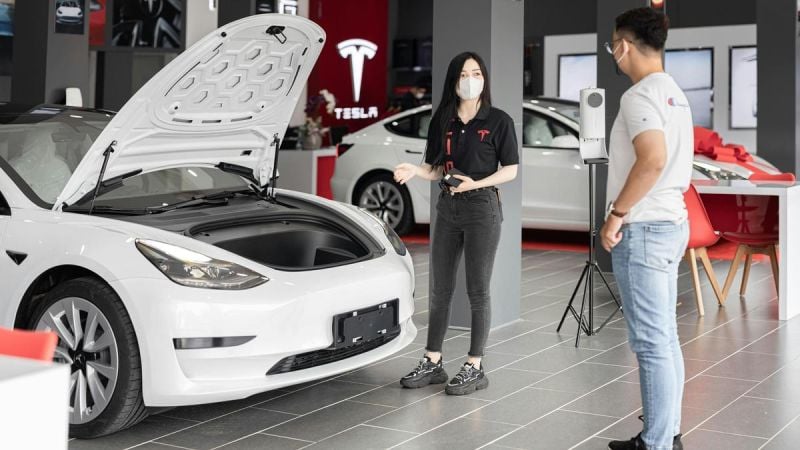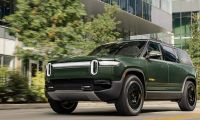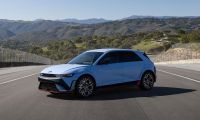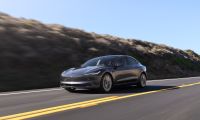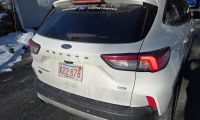Tesla’s software is astonishing. It’s not just better than the competition, it’s so far ahead that even the second-best offering feels like a lackluster experience. Tesla treated its cars like smartphones from the jump, designing its own chips, its own OS, its own update pipeline.

While Ford and GM were still sourcing infotainment systems from the lowest bidder and patching their UIs together like a Craigslist gaming PC, Tesla was refining an experience that doesn’t just feel responsive, it feels alive. As Reddit user aiakos noted,
“Tesla had to design most electronics in-house and write their own software.”
Giving them control that the old guard can only dream of.
The Car Just Works
That control means the car works like no other, and once people drive a Tesla, it’s hard to go back. From remote climate control to GPS-based user profiles, to route-aware battery preconditioning and flawless over-the-air updates, Tesla has made software the central nervous system of the ownership experience. You don’t fiddle. You don’t wait. You don’t have to scream at a voice assistant that thinks “navigate to Walgreens” means “call Mom.” It. Just. Works. As mredditer put it:
“They’ve done a good job at making sure you rarely have to fiddle with anything… You just get in the car and drive.”
And for many, that becomes the problem. Once you’ve tasted the seamlessness of Tesla’s interface, everything else feels like a downgrade, even if it’s objectively a better car.
Why Tesla’s UI Is So Good
- Tesla centralizes nearly all vehicle functions within a large, responsive touchscreen, offering a clean and modern aesthetic. This approach simplifies the dashboard but can require drivers to navigate menus for basic tasks, potentially leading to distraction. In contrast, many other manufacturers retain physical buttons for essential functions, balancing modern design with tactile accessibility.
- Tesla frequently enhances its vehicles through over-the-air software updates, introducing new features and improvements without the need for dealership visits. This continuous evolution keeps the user experience fresh and responsive to feedback. While some competitors have begun implementing similar update capabilities, Tesla's system remains among the most comprehensive.
- Tesla's UI does not support Apple CarPlay or Android Auto, limiting direct integration with some users' preferred smartphone ecosystems. This contrasts with many other manufacturers that offer such integrations, providing users with familiar interfaces and app access. However, Tesla's proprietary system offers a cohesive experience tailored specifically to its vehicles, emphasizing seamless internal functionality over external app compatibility.
A user named daddyfatsacks22 recently traded a Cybertruck for a GMC Sierra EV and described the new software as “legit laughable,” like going from iOS 17 to a 2004 Dell. Another, ShootyHoops, jumped from a Model 3 to a Volvo C40 and found the Android-based system good enough… until the speedometer disappeared mid-drive. These aren't edge cases, they’re signs that legacy automakers still don’t get it.
The Issue With Tesla
SheIsSoLost, the original poster, encapsulates the entire paradox:
“A friend convinced me to ride in a Tesla, and I was blown away by the software.
I’m someone who hates cars and loves computers, so it’s probably obvious why it interested me. Even so… I couldn’t bring myself to get one for reasons everyone already knows.”
This is the tightrope many EV buyers walk: you want the Tesla tech, but you don’t want the baggage, be it corporate behavior, build quality, or brand culture. Unfortunately, if tech is your main motivator, there’s nowhere else to go.
And that’s the deeper issue, EVs today live in a strange liminal space between traditional driving joy and bleeding-edge digital convenience. Tesla’s dominance in the tech world means that anyone else trying to appeal to tech-first buyers needs to deliver something at least comparable.
The Partnership With Rivian
- The partnership allows Volkswagen to incorporate Rivian's cutting-edge software and zonal electrical architecture into its future EVs. This integration is expected to streamline vehicle electronics by reducing the number of electronic control units and wiring, facilitating over-the-air updates, and supporting advanced automated driving features.
- Leveraging the joint venture's technology, Volkswagen plans to launch new EV models, such as the ID.EVERY1, a compact electric car priced around €20,000 ($21,500), targeting the European market by 2027. This initiative aims to make EVs more accessible to a broader consumer base.
- The collaboration provides Rivian with significant financial support, including Volkswagen's investment of up to $5.8 billion, aiding in scaling production and technology development. For Volkswagen, the partnership offers access to Rivian's software expertise, accelerating its transition to software-defined vehicles. Additionally, the joint venture's technology is attracting interest from other automakers, indicating its potential influence on the broader automotive industry.
Rivian is close, they own ABRP and have real-time integration with charging and route planning, but they’re stuck selling lifestyle trucks for now.
“I’ve heard Rivian is 2nd place, but the fact that they only sell huge trucks makes it a no-go.”
SheIsSoLost wrote, echoing what many tech-oriented urbanites are thinking.
The rest of the industry? Mostly hoping you’re satisfied with Apple CarPlay and Android Auto. Sure, they work for music.

But real EV software isn’t just about mirroring your phone. As death_hawk observed,
“AA/CarPlay is a crutch for those with bad infotainment systems.”
Legacy brands punted the problem to Big Tech, while Tesla built its own playbook. And even when manufacturers try, like Polestar with Android Automotive, they still suffer from lag, bugs, and baffling UX decisions. The dream of seamless car tech often dies in a poorly optimized boot screen.
Volkswagen's Rivian Powered Vehicles
So we arrive at the frustrating conclusion, the best tech lives in a car that many people don’t want to buy. Until VW’s Rivian-powered cars arrive (2026, according to Redditor b9918), or Rivian drops the R2 and R3, there’s no true competition. And even then, Tesla has a decade-long head start and a software pipeline that evolves weekly. EVs were supposed to be the bridge between the analog past and the digital future. But in 2025, it feels more like a fork in the road: do you want to drive a car, or run a device? Right now, you can’t have both.
If you had to pick just one, which brand do you think has the best UI in the entire automotive industry? What influenced your decision?
Leave your thoughts in the comments below.
Image Sources: Tesla Media Center, Ford Media Center
Noah Washington is an automotive journalist based in Atlanta, Georgia. He enjoys covering the latest news in the automotive industry and conducting reviews on the latest cars. He has been in the automotive industry since 15 years old and has been featured in prominent automotive news sites. You can reach him on X and LinkedIn for tips and to follow his automotive coverage.


